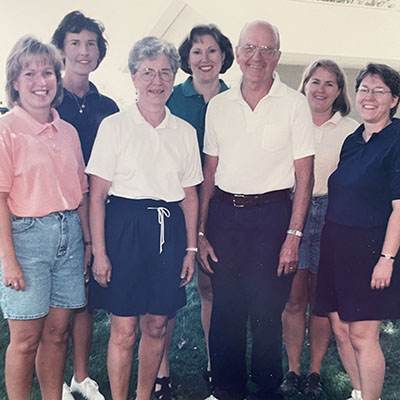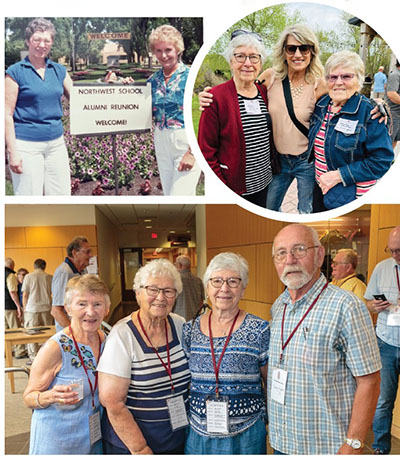

Imagine sending your 13 year-old to live on their own at a school two hours away. Nowadays it’s not a common thing, but in the early to mid 1900s it was something families did to help prepare their teens for adulthood. Attending the Northwest School of Agriculture (NWSA) was a family tradition for the Overgaards who lived on a St. Olaf Township farm in Dalton, Minnesota, and alumna Ardis (Overgaard) Searles 1951 got to take part. Her dad, Archie, attended the NWSA in 1927-28, plus their lifelong family friends and neighbors, the Thormodson family, did as well, so it was fitting Searles and her siblings (and their neighbors) transitioned together from the district school near Dalton to the “ag school” up north in Crookston. When they were just 13 years old, Searles and her friend, Mavis (Thormodson) Degelman 1951, packed their bags and made the trek with their fathers to the NWSA.
Lucky for Searles, she and Degelman got to be roommates their first year. As freshmen they stayed on the third floor of the “new dormitory”, otherwise known as McCall Hall, and would walk to their classes each day. When the holidays came around, Thanksgiving, Christmas, and Spring Break in February, they would ride the train from Crookston to Dalton to be with their families, and then back again to the NWSA.
“It was a learning experience, a life-changing experience, yet we made such good friends,” explained Searles. “I have friends from back then that are still very special to me.”

Searles recalls the classes she took at NWSA, special projects, and extracurricular activities. One in particular that stands out was swimming class.
“We would have to walk to the pool at the other end of what is now the university’s campus mall and we’d walk over in Minnesota temperatures, so very cold and chilly, plus we’d have wet hair at our next class,” she remembered.
Another unique memory was how students would launder their clothes while at school. “We didn’t have washing machines at the dorms, so we would send our dirty laundry home in this box, a laundry box, and our mom would wash them and send them back,” Searles shared. “We had a little post office at school, so we didn’t have to go downtown. We’d mail the box that was the size of a flat fruit box and by the next week or so we’d have clean clothes again.”
A few of her favorite classes and teachers were English/literature with Alice Ittner and Margaret Larsen, math with Alvey Pilkey, and typing with Fae Hughbanks, though her “specialty”, Searles says, was home economics which had a special project where they “lived” in an apartment above the nurse’s office and had to plan, shop for, and prepare meals, and do housekeeping. Other involvements during the school year for her were piano lessons, choir, and being a part of the National Honor Society.
Unlike more traditional junior high and high schools now, NWSA students were required to take classes and do projects at home over the summers.

“We were only in school for six months then, and I remember Mr. Lysaker would come around to our homes and make sure our homework was up to date,” Searles recalled. “We had books for the summer and had to keep track of what we were doing. Things were quite different then.”
After graduating their advanced year, which was the year after senior year, Searles’ class was ready to be done and go on to find a new life. Searles went to an employment office in Fergus Falls, Minnesota and received training and a job as a dental assistant. A few years later she married and had two children. Her husband was in the military service and they lived in Germany for a while before returning to the U.S. Sadly, Searles’ husband passed away suddenly after returning to the states so she went back to work for the dentist, and her parents helped with her daughters. She later met a banker who worked across the street and they married and had three daughters of their own. They celebrated 63 years of marriage before he passed away a few years ago.
Searles was lucky to be able to stay home and raise her children, and passed the time while providing “a little income” by decorating cakes for special occasions.
“I decorated cakes for several years, and made cakes for a lot of weddings,” Searles shared. “My husband was a very careful driver, so we got them where they needed to be. There were no accidents, but one time the humidity was ‘uffda’ and a cake sagged a little but nothing fell totally apart.”

“I’ve had a very good life, not very flamboyant, but very down to earth living,” she added.
Now, Searles enjoys walking outdoors (weather permitting) and loves to take in the homes and “meticulous” yards in surrounding neighborhoods. She also loves to catch up with friends and fellow alumni.
“I attended the Brew Bash in Fergus Falls this year and wondered who in the world would be coming to a gathering in Fergus Falls, but the first person I ran into was my cousin, Stanley Overgaard 1965,” Searles mentioned. “I went with a classmate to the event and it was fun to see other people, and others who have gone to the university and the ‘ag school’. I was telling my siblings about it and they were interested as they’ve never had an alumni gathering or something like it in Fergus Falls before.”
Searles has tried to get to as many all-school reunions on campus as she could, and served on the NWSA alumni board in the past. Once, she and a friend drove to Crookston in a snowstorm for a board meeting and ended up staying overnight because the weather got worse.
“Being at the school was an adventure, a good adventure,” Searles declared. “There were many friendships formed and it’s always fun to go back and reminisce. You think about 1951, when we graduated, and where we are now. The campus is the same, but different.”
Written for the 2023 Torch magazine


